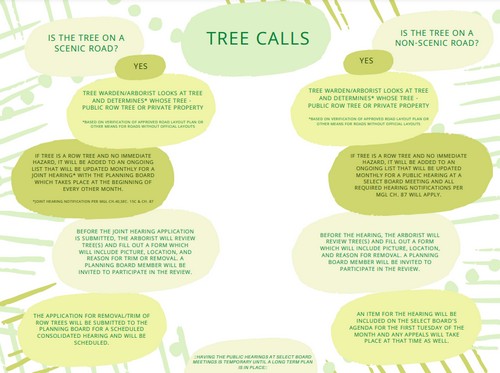Above: A “simple” flow chart for “interim” decisions about removing Public Shade Trees was approved by the Select Board but still to be discussed by the Planning Board.
As I’ve previously covered, the Planning Board has been seeking to improve the Town’s decision making process for removing Public Shade Trees.* (The process also covers restricted approval for planting new trees within the public right of way.) Since I last wrote about their discussions with the Select Board and Public Works, there have been some developments.
Tree Warden Temporarily Reappointed
The Select Board has voted to temporarily reappoint the former Tree Warden. The Warden had resigned from his stipended duty earlier this winter. The Select Board is still unresolved on how to fill that post going forward. In the interim, they learned that their Board would be considered the Tree Warden until someone new is hired/contracted.
But on March 24th, Chair Lisa Braccio explained that the former Warden was willing to resume his duties through June 30th, perhaps longer if needed. It’s an interim agreement while the Board looks into their next steps.
Temporary Process for Determining Tree Removals
This week, Braccio updated that she and Planning Board’s Meme Luttrell had come up with a “very simple” interim process for handling tree removals. A flow chart describes the process the Tree Warden will follow for requested removals of trees that aren’t imminent hazards.
The process is intended as a stop gap measure until a long term process is agreed upon by the Select and Planning boards. That may be in the form of a bylaw that Planning is seeking to pass at Annual Town Meeting. (Scroll down for more on that.)
Hearings would be held for trees that are determined to be Public Shade Trees. Hearings for trees on scenic roads will be at Planning Board meetings (bi-monthly). Hearings for trees on non-scenic roads would be held at Select Board meetings.
During the discussion, Braccio clarified that the DPW doesn’t need to wait for a hearing to deal with trees that pose a hazard. No detail was provided on how that is determined.
Past Planning Board discussions have highlighted that the Tree Warden had previously approved removal of trees he determined were hazards that residents subsequently claimed weren’t really hazards. That has been at the heart of much of Planning’s and Public Works’ disagreement over a tree removal process.
The Select Board approved the new process “flow chart” on Tuesday night. Braccio expected Luttrell to bring the process to the Planning Board at their next meeting. (Although, as of this morning, the agenda for their April 11th meeting doesn’t reference it.)
You can view the pdf of the chart here. (I’ve also inserted images of the Scenic Road and Non-Scenic Road processes below.)
Braccio also noted that April 25th is the tentative date for the Planning Board and Tree Warden’s hearing on removal of a tree at the intersection of Flagg and Deerfoot roads. (Though, again, no agenda or hearing notice have been posted as of this morning.)
Planning Board’s Scenic Roads and Tree Bylaws
The Select Board and Advisory Committee have expressed dismay that the Planning Board wasn’t willing to push its proposed Tree Bylaw to a Special Town Meeting in the fall.
Select Board member Andrew Dennington and Advisory Chair Kathy Cook publicly worried that the Article would prompt long debate, extending what was already looking to be a multi-night Annual Town Meeting. (Cook noted that there are several Citizen Petition Articles on the Warrant.)
Last week, Planning Chair Don Morris spoke about the public discussions, but clarified his Board hadn’t received an “official” request to delay the Article. He said he was “curious” why they would be asked to delay their Article unless other non-financial Articles were also asked to be delayed.
Resident Tim Litt commented that he had heard officials refer to the Article as both controversial and perceived as “not ready”. (He noted that wasn’t his view.)
Morris and member Marnie Hoolahan asserted that the bylaw was ready. Member Andrew Mills said that people with concerns should voice them at their public hearings.
Luttrell stated that when she spoke to Cook, she learned that the Advisory Chair mistakenly believed the bylaws were a reaction to trees cleared for the St. Mark’s pocket park last fall. She explained that Planning has been working on the initiative for two years.
On Tuesday night, two Select Board members continued to refer to the Article as not ready.
Member Marty Healey said the Article included several items that were legally problematic, including reference to a revolving fund for trees that doesn’t exist. Town Administrator Mark Purple referred to a related section at the end of their Article. It would amend other bylaws to add the revolving fund. He said that Town Counsel has advised Planning that they can’t do it that way. But he wasn’t privy to the full back and forth between Planning and Counsel.
Healey also expressed discomfort with the “extraordinary power” that the bylaw would grant to a Tree Warden – an unelected official. He opined delaying to a Fall Town Meeting would give the Town time to get the bylaw right. He was against rushing something to Town Meeting with the force of law and penalties in it.
Dennington said that as the Articles stand, he would vote not to support the Tree Bylaw or the Scenic Roads bylaw. He disagreed with Planning’s outlook that all Town roads should be Scenic Roads. To him, that undermined the whole concept of scenic roads.
Braccio reiterated that the Planning Board believes that they are ready to proceed with Articles for Annual Town Meeting. She said they could try to have a conversation with them, but believed it would require a commitment by the Select Board that there will be a Town Meeting in the fall.
The Board decided to hold off on voting their position on the Articles until they have a chance to speak with Planning Board. That could be at Select Board’s April 12th meeting, or the Select Board may join the Advisory Committee when they hold a discussion with Planning on the topic.
You can read more background on the bylaws here. I’ll note that in that story, I focused on the restrictions and process for removing Public Shade Trees. I didn’t cover the restrictions on planting new ones that are also in the bylaw.
Under Jurisdiction, it states that that the Tree Warden must issue standards for planting trees that includes “listing of trees acceptable for planting”. Later language makes clear that only native species can be used for new Public Shade Trees.
The following sections are under “E. Planting New Trees within the Public Right of Way”:
(1)Any property owner may petition the Tree Warden to plant a tree within a Public Right of Way. It is understood that some rights-of-way are not suitable for the planting of trees and that some species of trees are not suitable for public rights-of-way. For this reason, it is understood that the permit is discretionary on the part of the Tree Warden and is not to be construed as a right. . .
(2) (c) The petitioner shall work with the Tree Warden to select an appropriate native species tree and location that will not interfere with buried or above ground utilities and will minimize root damage to streets and sidewalks.
You can read Planning’s updated drafts here. The above language is not entirely consistent with the Board’s currently posted Street Tree Guidelines. The guidelines do prefer native species but also allow for some “native cultivars”.
However, it is consistent with many of the Planning Board’s discussions with permit seekers over the past few years. Many applicants have been pushed to plant native species. In a recent hearing on 154-156 Turnpike Road Modification to a Major Site Plan Approval, Luttrell explained that planting native species was requested as part of the landscaping plan.
She noted that the project was supposed to be a low impact development. Native plantings were meant to help mitigate destruction the project would cause. She followed that native species have co-evolved with native pollinators. She referred to cultivars with berries that birds can’t eat. She said they were beautiful to look at but not helpful to the environment.
*A Public Shade Tree’s definition includes ones on or within 20 feet of the public right-of-way, except on state highways. It’s worth noting that, according to Planning Board Chair Don Morris, the public right-of-way width/boundary varies greatly on the country roads. While the DPW has road plans that show it, it’s not something easily determined by the average resident.




